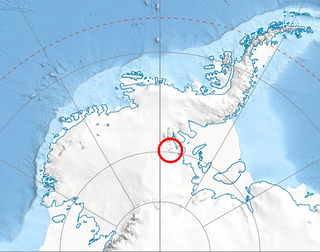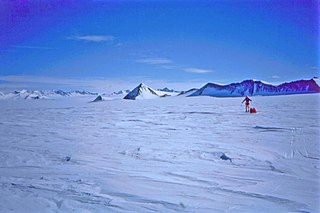
The Independence Hills are a line of rugged hills and peaks, 10 miles (16 km) long, with mainly bare rock eastern slopes. They lie 3 miles (5 km) southeast of the Marble Hills and form the southern segment of the west wall of Horseshoe Valley, in the Heritage Range of Antarctica. The Independence Hills were mapped by the United States Geological Survey from ground surveys and U.S. Navy air photos, 1961–66. The name was applied by the Advisory Committee on Antarctic Names in association with the name "Heritage Range".

Jaburg Glacier is a broad glacier draining westward between the Dufek Massif and the Cordiner Peaks in the Pensacola Mountains of Antarctica. It was mapped by the United States Geological Survey from surveys and U.S. Navy air photos, 1956–66. The glacier was named by the Advisory Committee on Antarctic Names after Lieutenant Conrad J. Jaburg, U.S. Navy, a helicopter pilot with the Ellsworth Station winter party, 1957.
Buggisch Peak is a peak rising to 1,445 metres (4,740 ft), 1 nautical mile (2 km) southwest of Lester Peak, Edson Hills, in the Heritage Range, Ellsworth Mountains, Marie Byrd Land. It was mapped by the United States Geological Survey from surveys and from U.S. Navy aerial photographs, 1961–66, and named by the Advisory Committee on Antarctic Names after Werner Buggisch, a German member of the field party with the United States Antarctic Research Program Ellsworth Mountains Expedition, 1979–80, led by Gerald F. Webers.
Carnell Peak is a peak, 1,730 metres (5,680 ft) high, in the Watlack Hills, situated 2.5 nautical miles (5 km) from the southeast end of the group, in the Heritage Range, Ellsworth Mountains. It was mapped by the United States Geological Survey from surveys and from U.S. Navy air photos, 1961–66, and named by the Advisory Committee on Antarctic Names for Lieutenant D.L. Carnell, Civil Engineer Corps, U.S. Navy, maintenance officer at Williams Field, McMurdo Sound, in the 1965–66 season, who was responsible for the first piercing of the Ross Ice Shelf at 50 meters.
The Enterprise Hills are a prominent group of largely ice-free hills and peaks in the form of an arc. The feature extends for about 30 nautical miles (60 km) to form the north and northeast boundary of Horseshoe Valley in the Heritage Range of the Ellsworth Mountains. These hills were mapped by the United States Geological Survey from surveys and U.S. Navy air photos, 1961–66; the name was applied by the Advisory Committee on Antarctic Names in association with the name Heritage Range.
Nimbus Hills is a rugged line of hills and peaks about 14 nautical miles (26 km) long, forming the southeast part of Pioneer Heights in the Heritage Range, Ellsworth Mountains. Mapped by United States Geological Survey (USGS) from ground surveys and U.S. Navy air photos, 1961-66. Named by Advisory Committee on Antarctic Names (US-ACAN) after the National Aeronautics and Space Administration weather satellite, Nimbus, which took photographs of Antarctica from approximately 500 nautical miles (900 km) above earth on September 13, 1964.

Crosswell Glacier is a glacier 10 nautical miles long, flowing north-northeast from Mount Shinn between Sullivan Heights and Bearskin Ridge, in the central part of the Sentinel Range, Ellsworth Mountains, Antarctica. Together with Patton and Pulpudeva Glaciers, it enters Ellen Glacier northwest of Mamarchev Peak and southeast of Mount Jumper.
Pirrit Hills is an isolated group of rocky peaks and nunataks about 7 nautical miles (13 km) in extent, lying southward of the Ellsworth Mountains, between the Heritage Range and Nash Hills. The feature was positioned by the U.S. Ellsworth-Byrd Traverse Party in December 1958. It was named by the Advisory Committee on Antarctic Names (US-ACAN) for John Pirrit, a glaciologist with the traverse party who had wintered at Ellsworth Station. Pirrit was scientific leader at Byrd Station in 1959.
The Edson Hills are a group of mainly ice-free hills lying south of Drake Icefall and west of Union Glacier in the Heritage Range of the Ellsworth Mountains in Antarctica. They were named by the University of Minnesota Ellsworth Mountains Party, 1962–63, for Dean T. Edson, a United States Geological Survey topographic engineer with the party.

Evans Peak is a prominent rock peak, 3,950 metres (12,960 ft) high, standing 3 nautical miles (6 km) east-northeast of Mount Ostenso in the Sentinel Range of the Ellsworth Mountains, Antarctica. It overlooks Rumyana Glacier to the north and Patton Glacier to the south. The peak was named by the University of Minnesota Geological Party to these mountains, 1963–64, for John Evans, a geologist with the party.

Mount Mohl is a mountain, 3,710 metres (12,170 ft) high, at the east side of Vinson Massif, surmounting the ridge between the heads of Dater Glacier and Thomas Glacier, in the Sentinel Range of the Ellsworth Mountains, Antarctica. It is connected to Doyran Heights to the northeast by Goreme Col.
Morris Cliff is a steep, east-facing cliff between the Marble Hills and Independence Hills in the Heritage Range of the Ellsworth Mountains in Antarctica. It was named by the Advisory Committee on Antarctic Names for Lieutenant Harold M. Morris, U.S. Navy, a pilot of LC-47 aircraft, who perished in a crash on the Ross Ice Shelf, February 2, 1966.
Moulder Peak is a sharp peak 3 nautical miles (6 km) southeast of Mount Rosenthal in the Liberty Hills of the Heritage Range, Antarctica. It was named by the Advisory Committee on Antarctic Names for storekeeper Andrew B. Moulder, U.S. Navy, who was fatally injured in a cargo unloading accident at South Pole Station, February 13, 1966.

Mount Hubley is a prominent, snow-covered, outlying mountain to the west of Mount Hale, in the Sentinel Range of the Ellsworth Mountains in Antarctica. It was first mapped by the United States Geological Survey from surveys and U.S. Navy air photos from 1957–59, and was named by the Advisory Committee on Antarctic Names for Richard C. Hubley, a member of the Technical Panel on Glaciology in the U.S. National Committee for the International Geophysical Year.

Lanz Peak is a peak, 1,570 metres (5,150 ft) high, near the extreme northern end of the Sentinel Range in the Ellsworth Mountains of Antarctica. It is 10 nautical miles (19 km) north-northwest of Mount Weems and is the middle one of a group of three peaks lying in a northeast–southwest direction. The peak was discovered by Lincoln Ellsworth on his trans-Antarctic flight of November 23, 1935, and was named by the Advisory Committee on Antarctic Names for Walter J. Lanz, a radio operator on three Ellsworth Antarctic expeditions between 1933 and 1936.

The Liberty Hills are a line of rugged hills and peaks with bare rock eastern slopes, about 10 nautical miles (19 km) long, standing 7 nautical miles (13 km) northwest of the Marble Hills and forming part of the west wall of Horseshoe Valley, in the Heritage Range, Ellsworth Mountains, Antarctica. The Liberty Hills were mapped by the United States Geological Survey from ground surveys and U.S. Navy air photos, 1961–66. The name was applied by the Advisory Committee on Antarctic Names in association with the name Heritage Range. The remarkable High Nunatak towers east of the Hills.








